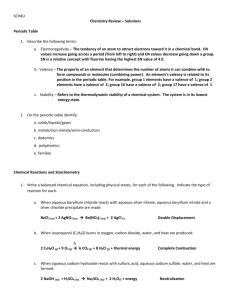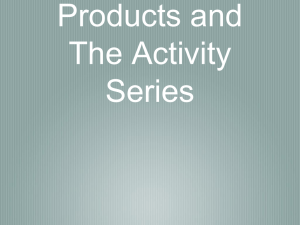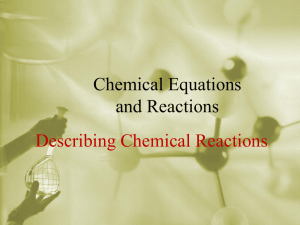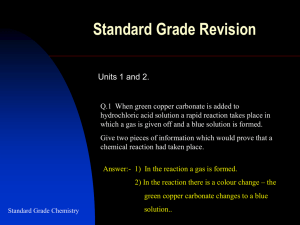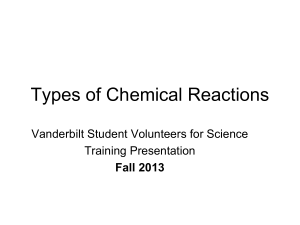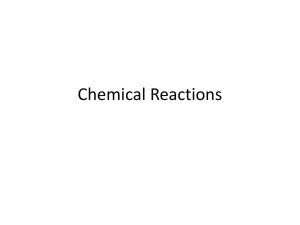Chemical Reactions
advertisement
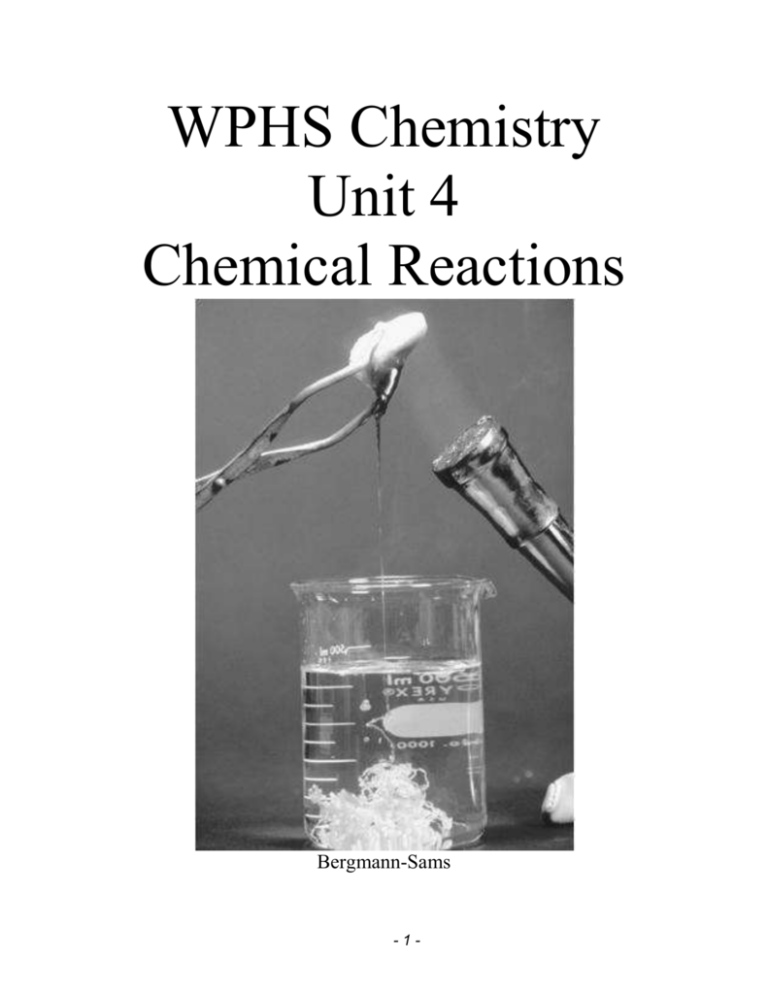
WPHS Chemistry Unit 4 Chemical Reactions Bergmann-Sams -1- Chemistry: Unit 4 Outline: Chemical Reactions Assignment Podcast 4.1: Converting Word Equations into Formulaic Equations Worksheet 4.1: Converting Word Equations into Formulaic Equations Podcast 4.2: Balancing Chemical Equations Worksheet 4.2: Balancing Chemical Equations Podcast 4.3: Reaction Types Overview Worksheet 4.3: Reaction Types Overview Lab: Types of Reactions Lab Podcast 4.4: Predicting Single Replacement Reactions Worksheet 4.4: Predicting Single Replacement Reactions Lab: Activity Series of a Metal Podcast 4.5: Predicting Double Replacement Reactions Worksheet 4.5: Predicting Double Replacement Reactions Lab: Small Scale Double Replacement Podcast 4.6: Complete Ion and Net Ionic Equations Worksheet 4.6: Complete Ion and Net Ionic Equations Podcast 4.7: Mixed Types of Reactions Worksheet 4.7: Mixed Types of Reactions Demo: Light your teacher on FIRE!!! Unit 4 Review (Review) Unit 4 Vocabulary Unit 4 Exam Unit 4 Vocabulary word equation chemical equation skeleton equation Catalyst Combination Reactions Decomposition Reaction Single Replacement Reaction Double Replacement Reaction precipitate Combustion Reaction Ion Ionic and Net Ionic Equations -2- Only in Class X X X X X Check Cut out the following 2 tables and put them in the back of your composition book. These are reference tables that you will use throughout the year. Activity of Metals Series Metal Lithium: Li Potassium: K Barium: Ba Calcium: Ca Sodium: Na Magnesium: Mg Aluminum: Al Manganese: Mn Zinc: Zn Chromium: Cr Iron: Fe Cadmium: Cd Cobalt: Co Nickel: Ni Tin: Sn Lead: Pb Hydrogen: H Copper: Cu Silver: Ag Mercury: Hg Platinum: Pt Gold: Au Ion Formed Li+ K+ Ba2+ Ca2+ Na+ Mg2+ Al3+ Mn2+ Zn2+ Cr3+ Fe3+ Cd2+ Co2+ Ni2+ Sn2+ Pb2+ 2H+ Cu2+ Ag+ Hg2+ Pt2+ Au3+ Solubility Table Key: (s) = solid, (aq)= aqueous: soluble in water, H2O = water formed (NE)= does not exist, Acetate Bromide Carbonate Chlorate Chloride Chromate Hydroxide Iodide Nitrate Oxide Phophate Sulfate Sulfide Aluminum Ammonium Barium Calcium Copper II Hydrogen Iron II Iron III Lead II Magnesium Manganese II Mercury II Potassium Silver I Sodium Strontium Tin II Tin IV Zinc II (aq) (aq) (aq) (aq) (aq) (aq) (aq) (aq) (aq) (aq) (aq) (aq) (aq) (aq) (aq) (aq) (aq) (aq) (aq) (aq) (aq) (aq) (aq) (aq) (aq) (aq) (aq) (s) (aq) (aq) (aq) (aq) (s) (aq) (aq) (aq) (aq) (aq) NE (aq) (s) (s) (s) Gas (s) NE (s) (s) (s) NE (aq) (s) (aq) (s) NE NE (s) (aq) (aq) (aq) (aq) (aq) (aq) (aq) (aq) (aq) (aq) (aq) (aq) (aq) (aq) (aq) (aq) (aq) NE (aq) (aq) (aq) (aq) (aq) (aq) (aq) (aq) (aq) (s) (aq) (aq) (aq) (aq) (s) (aq) (aq) (aq) (aq) (aq) NE (aq) (s) (aq) NE NE NE (s) (s) (aq) NE (s) (aq) (s) (aq) (s) (s) (aq) (s) (s) (aq) (s) (s) (s) H2O (s) (s) (s) (s) (s) (s) (aq) (s) (aq) (aq) (s) (s) (s) (aq) (aq) (aq) (aq) (aq) (aq) (aq) (aq) (s) (aq) (aq) (aq) (aq) (s) (aq) (aq) (aq) (aq) (aq) (aq) (aq) (aq) (aq) (aq) (aq) (aq) (aq) (aq) (aq) (aq) (aq) (aq) (aq) (aq) (aq) (aq) (aq) (aq) (s) NE (aq) (s) (s) NE (s) (s) (s) (s) (s) (s) (aq) (s) (aq) (aq) (s) (s) (s) (s) (aq) (s) (s) (s) (s) (s) (s) (s) (s) (s) (s) (aq) (s) (aq) (s) (s) NE (s) (aq) (aq) (s) (s) (aq) (aq) (aq) (aq) (s) (aq) (aq) (aq) (aq) (aq) (aq) (aq) (aq) (aq) (aq) (s) (aq) (s) (s) (s) (s) (s) (s) (s) (s) (s) (s) (aq) (s) (aq) (aq) (s) (s) (s) -3- -4- Types of Reactions Lab Purpose: To observe the different types of reactions: single replacement, synthesis, decomposition, combustion, double replacement. Single Replacement (Zinc + Hydrochloric Acid) Synthesis (Hydrogen + Oxygen) Decomposition (Hydrogen Peroxide (H2O2)) Combustion (Cellulose (C6H12O6) + Oxygen) Double Replacement (Calcium Chloride + Sodium Carbonate) Part A: Single Replacement and Synthesis 1. 2. 3. 4. 5. Place one square of Zinc into a medium test tube. Add 10mL of 1.0M HCl Cover the test tube with your thumb Record observations Write the chemical reaction for this single replacement reaction 6. Have your partner light a wood splint 7. Release your thumb and immediately have your partner place the wood splint near the mouth of the test tube. 8. Record your observations 9. Write the chemical reaction for this synthesis reaction (water is a product). OBSERVATIONS and REACTIONS -5- Part B: Decomposition and Combustion 1. 2. 3. 4. Place 10ml of hydrogen peroxide into a medium test tube Add 0.2g of MnO2 (MnO2 is a catalyst and is not part of the reaction) Record your observations Write the chemical reaction for this decomposition reaction (products are water and oxygen gas) 5. While the decomposition reaction is still occurring light a wood splint, let it burn for a few seconds and blow it out. 6. While the wood splint is still glowing (but not burning), place it into the mouth of the test tube. 7. Record your observations 8. Write the chemical reaction for this combustion reaction between cellulous and oxygen. OBSERVATIONS and REACTIONS Part C: Double Replacement 1. Obtain 1mL of 1.0M Calcium Chloride and 1mL of 1.0M Sodium Carbonate 2. Mix the two solutions in a medium test tube 3. Record your observations 4. Write the chemical reaction for this double replacement reaction OBSERVATIONS and REACTIONS -6- Activity Series of Metals Lab Purpose: To observe an activity series of different metals. Procedure: 1. Using the well plates, select a row of wells for each solution listed in the data table. Make sure that you write down which letter and number your wells are for each solution. There should be three wells for each solution (one of the three for each of the metals). 2. Put five drops of each solution in the wells chosen for that solution. 3. Put one piece of magnesium in one of the wells for each solution. For example, you should have a well of copper sulfate with magnesium in it, a well of magnesium sulfate with magnesium in it, and a well of sodium chloride with magnesium in it, a well of zinc sulfate with magnesium in it and a well of silver nitrate with magnesium in it. 4. Repeat step 3 with copper instead of magnesium. 5. Repeat step 3 with zinc instead of magnesium. 6. After l minute has passed, make observations of both the metal strips and the solutions. Put these observations in a data table in your comp book that looks like the one below. Label this data table as 1 minute. 7. After 5 total minutes have passed, take another set of observations. Make another data table like the one below and label it 5 minutes. 8. After 15 total minutes have passed, take another set of observations. Again, make another data table and label it 15 minutes. Data Table: CuSO4 MgSO4 NaCl ZnCl2 AgNO3 Cu metal Mg metal Zn metal Analysis Questions: (as always with labs, these questions should be written in complete sentences) 1. Why doesn’t the metal react with the same metal solution? 2. In which wells did the appearance of the metal change? Be sure to tell your teacher what both of the reactants of the well were. 3. Write a balanced equation for each visible reaction between a metal and it’s solution. Be sure to identify what types of reactions these are. 4. Based on the results of your experiment construct your own activity series for the five metals. Put the most active metal first and the least active metal last. Be sure to include your reasoning for your rankings. 5. In a short summary paragraph, describe and explain the patterns that you see in your reaction table. -7- Double Replacement Lab Use Beral Pipets to add each solution on the grid. For those that have a reaction occur, describe the reaction. For those that do not, record NVR (No visible reaction) When done you need to: 1. Write out each complete reaction that occurs (you must balance it) 2. Write out the ionic equation for each reaction that occurs. 3. Write out the net-ionic equation for each reaction that occurs. Put “flimsy” over the top of this page and mix all of the chemicals. Do not mix the same chemical with the same. Chemical NaCl AgNO3 Pb(NO3)2 Na2SO4 BaCl2 NaOH Na3PO4 NaCl AgNO3 Pb(NO3)2 Na2SO4 BaCl2 NaOH Na3PO4 X X X X X X XX X X X X X X X X X X X X X X X X X X X X X X X X X X X X X X X X X -8- Data Table: Write in your observations here. Chemical NaCl AgNO3 Pb(NO3)2 Na2SO4 NaCl AgNO3 Pb(NO3)2 Na2SO4 BaCl2 NaOH Na3PO4 -9- BaCl2 NaOH Na3PO4 Worksheet 4.1: Converting Word Equations to Formulaic Equations Write each of the following equations using chemical symbols and all other appropriate symbols. Remember to put state of matter in parenthesis and subscripted. 1. Iron is heated in the presence of solid sulfur to from solid iron III sulfide 2. Gaseous methane CH4 is reacted with oxygen gas to form carbon dioxide gas and water vapor 3. Aqueous copper II chloride is added to aqueous lead II nitrate to from solid lead II chloride and aqueous copper II nitrate 4. Chlorine gas is bubbled into aqueous sodium bromide to form aqueous sodium chloride and liquid bromine 5. Solid silver is added to aqueous gold III chloride to form solid gold and silver I chloride. 6. Gaseous ammonia(NH3) is bubble into water to form aqueous ammonium hydroxide - 10 - Worksheet 4.2: Balancing Chemical Equations Balance the following equations 1) __HgO __Hg + __O2 2) __HCl + __Mg __H2 + MgCl2 3) __CH4 + __O2 __CO2 + __H2O 4) __C6H12O6 + __O2 __CO2 + __H2O 5) __H2 + __O2 __H2O 6) __H2 + __N2 __NH3 7) __NO + __O2 __NO2 8) __Al2O3 9) __CaO + __H2O __Al + __O2 __Ca(OH)2 10) Hydrogen gas reacts with iodine to produce hydroiodic acid. 11) Sulfur reacts with oxygen to produce sulfur dioxide. - 11 - 12) Calcium acetate reacts with sodium carbonate to produce calcium carbonate and sodium acetate. 13) Iron combines with oxygen and water to form iron (III) hydroxide 14) Sulfur trioxide is bubbled through water to produce sulfuric acid 15) Copper-bottomed cooking pans turn black because copper combines with oxygen to form copper (II) oxide. 16) Magnesium hydroxide neutralizes stomach acid, HCl, to produce magnesium chloride and water. - 12 - Worksheet 4.3 Now go back to Worksheets 4.1 and 4.2 and write down the type of each reaction Worksheet 4.4: Predicting Single Replacement Reactions Predict the products and balance the following single replacement reactions. If no reaction occurs write N.R. For transition metals use the following charges: 1. Fe (s) + CuCl2(aq) 2. Hg(l) + Sn(SO4)2 (aq) 3. Ba (s) + Ni3(PO4)2 (aq) 4. Pb(s) + Au(NO3)3 (aq) 5. Li(s) + HOH(l) 6. K(s) + AgCl(s) 7. Ca(s) + NaOH(aq) 8. Cu(s) + Fe(OH)3(aq) - 13 - 9. Fe(s) + Cu(OH)2(s) 10. Lead II Chloride + Magnesium 11. Barium Nitrate + Zinc 12. Potassium + Tin IV Nitrate 13. Copper + Silver Nitrate 14. Sodium Phosphate + Potassium 15. Gold + Hydrochloric acid 16. Magnesium + Aluminum Hydroxide - 14 - 17. Iron + Copper II Sulfate 18. Iron + Nickel II Iodide 19. Sodium Permanganate + Calcium 20. hydrochloric acid + Zinc 21. Aluminum + Iron II dichromate - 15 - Worksheet 4.5: Predicting Double Replacement Reactions Complete and Balance the following reactions. If no reaction occurs then write N.R. 1) Na2SO4 (aq) + Ba(NO3)2(aq) ----> 2) NaNO3(aq) + NH4Cl(aq) -----> 3) Pb(NO3)2 (aq) + Na2CrO4(aq) 4) ZnCl2(aq) + K2CO3(aq) ----> 5) Ammonium Chloride + Silver Nitrate ------> 6) Barium Acetate + Copper II Chromate - 16 - 7) Solutions of Silver Nitrate and ammonium chloride are mixed 8) Solutions of Lead II nitrate and Sodium Chloride are mixed 9) Solutions of zinc sulfate and magnesium chloride are mixed 10) Solutions of Ammonium phosphate and Zinc Chlorate are mixed 11) Solutions of Aluminum bromide and Iron II Iodide are mixed - 17 - 12) Solutions of sodium sulfide and Iron II Chlorate are mixed 13) Solutions of copper II bromide and potassium phosphate are mixed 14) Solutions of barium acetate and zinc sulfate are mixed - 18 - Worksheet 4.6: Complete Ion and Net Ionic Equations For the following reactions write the: a. Complete Equation (Indicate states): Balance b. Ionic Equation c. Net Ionic Equation 1. ZnCl2 (aq) + Na2S (aq) ZnS(s) + NaCl(aq) 2. (NH4)3PO4 + AgNO3 3. Magnesium Nitrate + Potassium phosphate Magnesium Phosphate (s) + Potassium Nitrate. 4. Lead II Acetate + Potassium Iodide - 19 - Worksheet 4.7: Mixed Types of Reactions Directions: For each of the following reactions: 1) Identify the type of reaction (Single Replacement, combination, double replacement, decomposition, or combustion) 2) Complete the reaction (Put NR if no reaction takes place) 3) Balance it 4) Indicate states of matter for each substance (solid, liquid, gas, aqueous) 1) NaCl(aq) + AgNO3(aq) 2) Fe(s) + CuSO4(aq) 3) C4H10(g) + O2(g) 4) Ba(NO3)2(aq) + Na2SO4 (aq) 5) AgNO3(aq) + Li(s) 6) LiBr(aq) + Cu(s) 7) MgS(s) + NaOH - 20 - 8) Hg(l) + LiCl 9) Li(s) + HgCl2(aq) 10) C3H8(g) + O2(g) 11) Ammonium Nitrate is added to sodium chloride 12) Lithium Chloride is added to Zinc Phosphate 13) Zinc is added to lithium chloride 14) Iron is added to a solution of silver nitrate - 21 - 15) A solution of copper II sulfate is added to an iron nail 16) Octane (C8H18) is burned in air 17) A solution of Tin IV sulfate is added to a solution of ammonium hydroxide 18) Sodium hydroxide is added to hydrochloric acid 19) Calcium hydroxide is added to sulfuric acid 20) Nickel is added to hydrochloric acid 21) Strontium is added to water 22) Hydrochloric acid is added to copper metal - 22 - 23) Solid bismuth is added to a solution of barium hydroxide. 24) Methanol (CH3OH) is burned in air 25) Solid gold is added to hydrochloric acid - 23 - Unit 4 Review Sheet Part A: Balance the following reactions and indicate whether they are synthesis or decomposition reactions. 1. 2. 3. 4. 5. SO3 + H2O HgO Al2O3(s) P + H2O ---> ---> ---> O2 ---> H2 Hg Al(s) ---> H2SO4 + O2 + O2 + O2(g) P2O5 Type:_____________ Type:_____________ Type:_____________ Type:_____________ Type:_____________ Part B: Predict the products and indicate type (include states): 1. KBr ---> Type: _________ 2. Li + Cl2 ---> Type: _________ 3. Rb2CO3 ---> Type: _________ 4. NiO ---> Type: _________ 5. CO2 + H2O---> Type: _________ Part C: Predict the products, balance, include states, and indicate type. 1. Molten sodium is reacted with chlorine gas 2. Calcium is added to water Type: _________ (think of water as HOH) Type: _________ 3. Aluminum chloride decomposes into its elements Type: _________ 4. Potassium and Bromine are reacted Type: _________ - 24 - 5. Iodine reacts with hydrogen Type: _________ Part D: Write the molecular equation, the complete ionic equation, and the net ionic equation for each reaction. 1. Aqueous lithium phosphate reacts with aqueous calcium chloride 2. Aqueous potassium chloride reacts with aqueous lead II chlorate 3. Aqueous manganese II nitrate reacts with aqueous sodium sulfide. - 25 -
